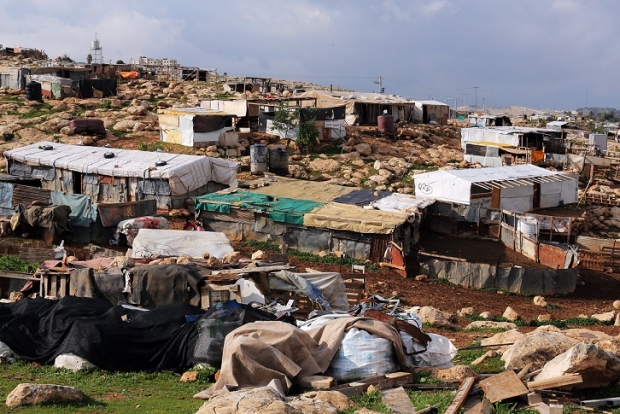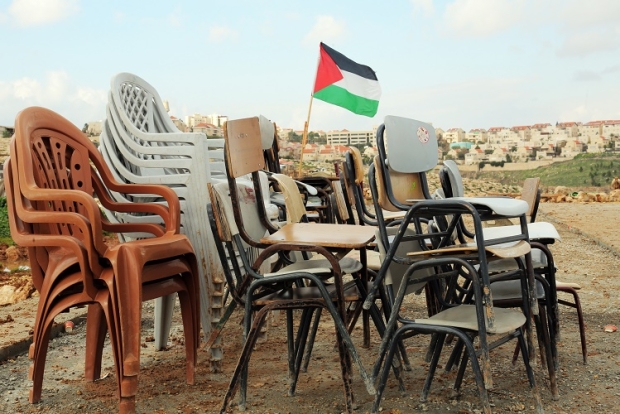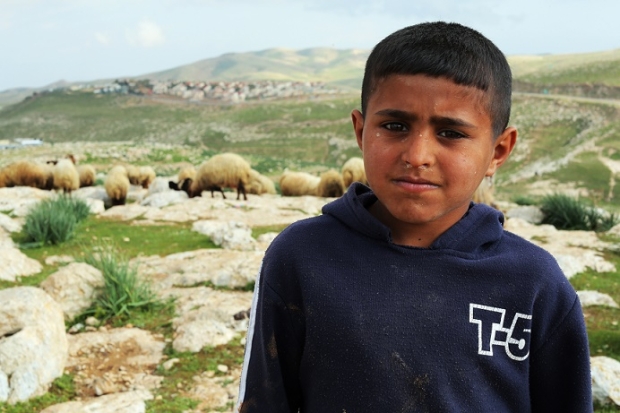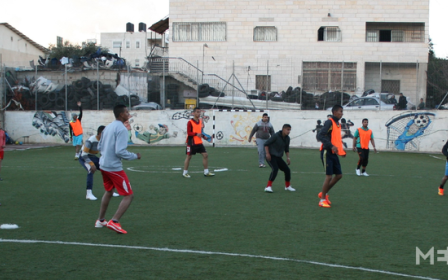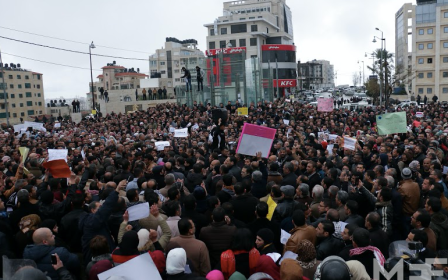Israeli forces demolish only school in Bedouin village

ABU AL-NAWAR, Occupied West Bank - Children in the Abu al-Nawar Bedouin community tried to go to school on Monday morning, but just an hour into classes it started to rain.
The primary school children gathered on flat concrete, the only remnants left of their school after Israeli forces stormed the village on Sunday and confiscated the donated caravan where classes used to be held.
“There was no way to continue classes today with nothing to protect them from the weather,” Abed Freya, a patriarch of the community told Middle East Eye. “We will have to come up with a way to provide shelter so the kids don’t continue to miss school.”
While the village was quiet on the stormy Monday afternoon, the havoc that erupted the day before was fresh on residents’ minds.
“The Israelis came with hundreds of soldiers and big trucks, they detached the caravan from the ground and just left with the whole structure,” Freya said.
Freya said the caravan was donated by French authorities to give primary school students a safer, more convenient place to study, rather than having to take a three-kilometre walk to the nearest city’s school as the older children in the community are already forced to do.
Next to the barren slab of concrete is a children’s early learning centre donated by the European Union for pre-school children. Freya explained that the learning centre is also at risk of demolition, but that the community has hired lawyers who are currently fighting the order in Israeli courts.
Freya said Israeli forces told them the reason for the demolition orders was that proper buildings were forbidden to be constructed in the community, where homes are made from scraps of corrugated metal and tarps that sprawl out over the land.
Israeli forces reportedly did not give residents of Abu al-Nawar time to fight the case for the primary school in court, as they issued the demolition order on Saturday - a day before they arrived to confiscate the structure.
“They even took the desks and chairs inside. They took everything except the concrete floor,” Freya said. “To be honest, I’m sure that our school is being set up right now at some Israeli settler outpost - chairs and all - I wouldn't be surprised.”
When MEE contacted the Coordinator of Government Activities in the Territories, the agency which is responsible for implementing Israeli policies in the West Bank, to ask why the school had been demolished, a spokesperson said that four caravans "were placed illegally and without permits on Friday and the civil administration's inspection unit obtained them on Saturday night."
Residents, however, said the confiscated structure was installed late last year.
Out in the open
As MEE spoke this week with Freya near the remnants of the school, a herd of sheep made their way over the school’s foundation, passing the mismatched stacks of chairs from Monday’s failed attempt at a lesson.
“See this, how would the kids learn out in the open like this? It is impossible,” Freya said.
The chairs stacked up on one corner of the concrete foundation were not left over by Israeli forces, Freya explained, but rather donated earlier that day by the Palestinian Authority (PA).
The PA’s Ministry of Foreign Affairs in a statement on Monday condemned the confiscation of the school.
“This case is just another example of Israel’s flagrant disregard for the lives of Palestinians,” the statement said.
The ministry demanded that international bodies “take immediate action to put an end to Israeli crimes and hold Israel accountable for its crimes and [for] the international community [to] stop treating Israel as a state above law”.
Freya said he expects international condemnation of the incident as well, particularly because the school that Israeli forces confiscated and the learning centre next to it were humanitarian donations from the international community.
The PA was not so patient, pointedly asking: “Where is the international community regarding the illegal demolition of Abu Nawar School that violates international law and humanitarian law?”
One woman, a mother with two children who attended the school, said she desperately hoped that officials from any side would be able to find a solution for her children.
“I don’t want the little ones to travel two miles to school on foot. It is too much for them and there aren’t buses here and we don’t have a car,” she said.
“It was so much better that the kids were being taught here in their own community than having to go to the city where the people are different and it’s all just more difficult to handle.”
While PA public teachers have been on strike for weeks as they battle with the government for union terms to be met, the woman said the public school teacher that travels to the Abu al-Nawar community never stopped showing up for school.
“We are in a particular situation here that is different, our life is difficult and the teacher understands that, the PA understands that, but Israel cannot have any sympathy for us, of all the things to demolish, they demolished a school,” she said.
String of demolitions
According to the United Nation’s Office for the Coordination of Humanitarian Affairs (OCHA), last month Israeli forces demolished five homes, five “donor-funded” latrines and an animal shelter in the Abu al-Nawar community.
As a result of the demolition, 26 people, including 18 children, were displaced.
The community is located on the other side of a hill on the edge of a residential area, technically in the Jerusalem district, but on the West Bank side of Israel’s separation wall.
The road up to the Abu al-Nawar is too difficult a terrain for a regular car.
The community is not visible until one travels up a muddied path that winds up a hillside, leading to the top of the mount, where clusters of makeshift homes stretch out over the land.
“We live a quiet life away from everyone. We leave everyone alone. Why can’t Israel just leave us be?” the mother said.
The answer to her question lies on the neighbouring hillsides, according to OCHA.
Not far off to the north is the illegal Israeli settlement of Ma’ale Adumim, while to the southeast is the small illegal Israeli settlement of Kidar, which Israel plans to connect with the larger Ma’ale Adumim.
According to OCHA, Abu al-Nawar is one of 46 Bedouin communities at risk of being forcibly displaced by Israeli forces.
“It is located within an area known as E1, which has been allocated for the expansion of the Ma’ale Adumim settlement westwards, creating a continuous built-up area between this settlement and East Jerusalem,” OCHA explained in a report.
According to Applied Research Institute - Jerusalem, a non-profit organisation promoting sustainable development in the occupied Palestinian territory, Israel plans to relocate the Bedouin community to “urban settings,” but “these relocation sites will make it impossible for Bedouins to practice their lifestyle”.
Last week, the UN announced that in the first six weeks of 2016, Israel has demolished half as many Palestinian structures as they did in all of 2015.
Abed al-Qaisi provided additional reporting for this story.
Middle East Eye propose une couverture et une analyse indépendantes et incomparables du Moyen-Orient, de l’Afrique du Nord et d’autres régions du monde. Pour en savoir plus sur la reprise de ce contenu et les frais qui s’appliquent, veuillez remplir ce formulaire [en anglais]. Pour en savoir plus sur MEE, cliquez ici [en anglais].


